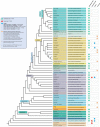Origin, Diversity, and Evolution of Telomere Sequences in Plants
- PMID: 32153618
- PMCID: PMC7046594
- DOI: 10.3389/fpls.2020.00117
Origin, Diversity, and Evolution of Telomere Sequences in Plants
Abstract
Telomeres are basic structures of eukaryote genomes. They distinguish natural chromosome ends from double-stranded breaks in DNA and protect chromosome ends from degradation or end-to-end fusion with other chromosomes. Telomere sequences are usually tandemly arranged minisatellites, typically following the formula (TxAyGz)n. Although they are well conserved across large groups of organisms, recent findings in plants imply that their diversity has been underestimated. Changes in telomeres are of enormous evolutionary importance as they can affect whole-genome stability. Even a small change in the telomere motif of each repeat unit represents an important interference in the system of sequence-specific telomere binding proteins. Here, we provide an overview of telomere sequences, considering the latest phylogenomic evolutionary framework of plants in the broad sense (Archaeplastida), in which new telomeric sequences have recently been found in diverse and economically important families such as Solanaceae and Amaryllidaceae. In the family Lentibulariaceae and in many groups of green algae, deviations from the typical plant telomeric sequence have also been detected recently. Ancestry and possible homoplasy in telomeric motifs, as well as extant gaps in knowledge are discussed. With the increasing availability of genomic approaches, it is likely that more telomeric diversity will be uncovered in the future. We also discuss basic methods used for telomere identification and we explain the implications of the recent discovery of plant telomerase RNA on further research about the role of telomerase in eukaryogenesis or on the molecular causes and consequences of telomere variability.
Keywords: Allium; Cestrum; Genlisea; circular chromosomes; green algae; linear chromosomes; telomerase; telomeres.
Copyright © 2020 Peska and Garcia.
Figures


References
-
- Adams S. P., Hartman T. P., Lim K. Y., Chase M. W., Bennett M. D., Leitch I. J., et al. (2001). Loss and recovery of Arabidopsis-type telomere repeat sequences 5'-(TTTAGGG)(n)-3' in the evolution of a major radiation of flowering plants. Proc. Biol. Sci. 268 (1476), 1541–1546. 10.1098/rspb.2001.1726 - DOI - PMC - PubMed
Publication types
LinkOut - more resources
Full Text Sources

